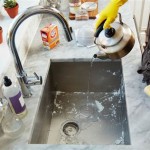Drain Size for Kitchen Sink: A Comprehensive Guide
The kitchen sink is a vital component of any household, facilitating tasks from food preparation to dishwashing. A properly functioning drain system is crucial for efficient drainage and the prevention of clogs and backups. One of the most important factors in ensuring optimal drainage is the drain size. Selecting the correct drain size is essential for preventing plumbing problems and maintaining a functional kitchen environment. This article provides a detailed examination of drain sizes for kitchen sinks, covering standard dimensions, considerations for different sink types, and factors influencing drain selection.
The term "drain size" refers to the inner diameter of the drainpipe that carries wastewater away from the sink. The proper drain size ensures that the volume of water and waste generated during daily use can be efficiently discharged without causing backups or slow drainage. Inadequate drain size can lead to clogs, foul odors, and potentially costly plumbing repairs. Conversely, an excessively large drain size may not be necessary and could complicate the plumbing installation process.
Understanding Standard Kitchen Sink Drain Sizes
The most common drain size for kitchen sinks is 1 1/2 inches (1.5"). This size is generally suitable for most residential kitchen sinks, accommodating the typical volume of water and food waste generated during regular use. The 1 1/2-inch drain size is a standard in the plumbing industry, and most sink accessories, such as strainers, garbage disposals, and P-traps, are designed to fit this size. Deviation from this standard is rare but may occur in specific circumstances, such as for sinks with exceptionally high water usage or in commercial settings.
While 1 1/2 inches is the standard, some older homes or specialized sinks might utilize a 1 1/4-inch drain size. This smaller size is sometimes found in bathroom sinks and occasionally in older kitchen installations. However, due to its limited capacity, the 1 1/4-inch drain is generally not recommended for modern kitchen sinks, as it is more prone to clogging and slower drainage. If replacing a sink with an existing 1 1/4-inch drainpipe, it is often advisable to upgrade the plumbing to the standard 1 1/2-inch size to improve drainage performance.
Another less common, but relevant size to understand is 2 inches. You will typically find this on the main drain line. It is important to ensure the size of the line remains constant or becomes larger as you move further down the drain system.
To accurately measure the drain size, it is necessary to measure the inner diameter of the drainpipe or the drain opening in the sink. This can be done using a measuring tape or calipers. It is crucial to measure accurately to ensure compatibility with drain fittings and accessories. When replacing an existing sink or drain, it is advisable to measure the existing drain size to ensure that the new installation matches the existing plumbing.
Factors Influencing Kitchen Sink Drain Size Selection
Several factors should be considered when determining the appropriate drain size for a kitchen sink. These factors include the sink type, the presence of a garbage disposal, the volume of water usage, and local plumbing codes. Understanding these factors can help in making an informed decision about the optimal drain size for a specific kitchen setup.
The type of kitchen sink can influence drain size selection. Single-bowl sinks, which are common in smaller kitchens or as secondary sinks, typically work well with the standard 1 1/2-inch drain. Double-bowl sinks, which are designed for washing and rinsing, may also function adequately with a 1 1/2-inch drain, provided that the plumbing system is properly vented and the drainage is efficient. However, for large or deep double-bowl sinks, or for sinks that experience high water usage, a larger drain size might be beneficial to ensure rapid and clog-free drainage.
The presence of a garbage disposal unit significantly impacts drain size considerations. Garbage disposals grind food waste into small particles that are then flushed down the drain. While most garbage disposals are designed to connect to the standard 1 1/2-inch drain, the increased volume of solid waste entering the drain system necessitates a robust drainage setup. It is essential to ensure that the drainpipe is free of obstructions and that the plumbing is properly vented to prevent clogs and backups. In some cases, a larger drainpipe or a dedicated drain line for the garbage disposal may be recommended, particularly in households with frequent garbage disposal use.
High water usage and the types of materials often sent down the drain can also affect drain size. Kitchens that are frequently used for heavy cooking and dishwashing generate a larger volume of wastewater and food debris. Similarly, kitchens where grease, fats, and oils are frequently disposed of down the drain are more prone to clogs and drainage problems. In such cases, a larger drain size or additional measures, such as grease traps, may be necessary to maintain optimal drainage and prevent plumbing issues. It is also crucial to educate household members about proper waste disposal practices to minimize the risk of clogs and backups.
Local plumbing codes and regulations may also dictate the permissible drain sizes for kitchen sinks. These codes are designed to ensure that plumbing systems meet minimum standards for safety and efficiency. It is essential to consult with a licensed plumber or building inspector to determine the specific requirements for drain sizes in a particular jurisdiction. Adhering to local codes is crucial for ensuring compliance and avoiding potential fines or penalties.
Practical Considerations for Drain Installation and Maintenance
Proper installation and maintenance of the kitchen sink drain are essential for ensuring long-term functionality and preventing plumbing problems. This includes selecting the right materials, ensuring proper connections, and implementing regular cleaning and maintenance practices.
Drainpipes can be made from various materials, including PVC (polyvinyl chloride), ABS (acrylonitrile butadiene styrene), and metal. PVC and ABS are common choices for residential plumbing due to their durability, cost-effectiveness, and ease of installation. Metal pipes, such as copper or brass, are more expensive but offer superior durability and resistance to high temperatures. The choice of material depends on factors such as budget, local codes, and personal preferences. It is essential to select materials that are compatible with the existing plumbing system to avoid corrosion or other problems.
Proper connections are crucial for preventing leaks and ensuring efficient drainage. All drain connections should be made using appropriate fittings and sealants to create a watertight seal. It is essential to follow the manufacturer's instructions carefully when installing drain components and to ensure that all connections are properly tightened. Regular inspection of drain connections is recommended to identify and address any leaks or potential problems before they escalate. In the event of a leak, the affected connection should be repaired promptly to prevent water damage and further plumbing issues.
Regular cleaning and maintenance are essential for preventing clogs and maintaining optimal drainage. Food debris, grease, and other materials can accumulate in the drainpipe over time, leading to clogs and slow drainage. To prevent this, it is recommended to flush the drain with hot water regularly, especially after disposing of greasy or fatty foods. Baking soda and vinegar can also be used to clean the drain and dissolve minor clogs. Pour a cup of baking soda down the drain, followed by a cup of vinegar. Let the mixture sit for 30 minutes, then flush with hot water. This can help to break down grease and debris and keep the drain flowing smoothly.
Avoid pouring fats, oils, and grease down the drain, as these materials can solidify and cause stubborn clogs. Instead, collect fats and oils in a container and dispose of them properly, such as in the trash or at a designated recycling facility. Similarly, avoid flushing large amounts of food waste down the drain, as this can overload the garbage disposal and contribute to clogs. Scrape food scraps into the trash or compost bin before washing dishes to minimize the amount of solid waste entering the drain system.
If a clog does occur, there are several methods for clearing it. A plunger can be used to dislodge the clog by creating pressure in the drainpipe. If the plunger is ineffective, a drain snake or auger can be used to break up or remove the clog. Insert the drain snake into the drainpipe and rotate it to break up the clog. Pull the snake out to remove the debris. In severe cases, it may be necessary to disassemble the drainpipe and manually remove the clog. If unsure about how to proceed, it is best to consult with a licensed plumber to avoid damaging the plumbing system.
Periodic inspection of the drainpipe for signs of corrosion, leaks, or damage is also important. Corrosion can weaken the drainpipe and lead to leaks or breaks. If corrosion is detected, the affected section of the drainpipe should be replaced. Leaks should be repaired promptly to prevent water damage and further plumbing issues. Addressing plumbing problems early can help to prevent more costly repairs in the future.
Ensuring proper venting of the plumbing system is also essential for efficient drainage. Vents allow air to enter the drainpipes, preventing vacuum and ensuring that water flows freely. Blocked or inadequate venting can lead to slow drainage, gurgling noises, and even sewer gas odors. Check the vents for obstructions and ensure that they are properly installed. If experiencing persistent drainage problems, consult with a licensed plumber to assess the venting system and make any necessary adjustments.
Finally, consider professional assistance when dealing with complex or persistent plumbing issues. A licensed plumber has the expertise and tools to diagnose and resolve plumbing problems safely and effectively. Attempting to fix plumbing problems without proper knowledge and experience can lead to further damage and potentially costly repairs. Consulting with a professional can provide peace of mind and ensure that the plumbing system is functioning optimally.
In summary, selecting the correct drain size for a kitchen sink involves considering the sink type, the presence of a garbage disposal, water usage patterns, and local plumbing codes. Proper installation and maintenance are essential for ensuring long-term functionality and preventing plumbing problems. By following these guidelines, homeowners can ensure that their kitchen sink drain system operates efficiently and reliably for years to come.
Key Takeaways on Kitchen Sink Drain Sizes
Choosing the suitable drain size for a kitchen sink is key to efficient drainage and preventing common plumbing issues. Making the right decision involves considering several aspects to ensure optimal performance and prevent future complications.
Firstly, the standard drain size for most residential kitchen sinks is 1 1/2 inches. This size generally accommodates typical water and waste volume, making it a safe choice for many installations. However, specialized scenarios may warrant a different approach. Older homes might have drains as small as 1 1/4 inches, though upgrading to the standard size is often advised. For main lines, 2-inch drains are common, and it's crucial to maintain or increase the drain size further down the system.
Secondly, factors like the type of kitchen sink, whether a garbage disposal is in place, and the amount of water usage significantly influence the drain size decision. Single-bowl sinks often function well with the standard size, but larger, double-bowl sinks or those used heavily might benefit from a larger drain. Garbage disposals, while compatible with standard drains, add to the solid waste volume, potentially requiring a more robust drainage system. High water usage and frequent disposal of grease necessitate careful consideration to avoid clogs.
Lastly, practical aspects of drain installation and maintenance are crucial for long-term functionality. Choosing the right materials (PVC, ABS, or metal) and ensuring proper connections can prevent leaks. Regular cleaning practices, such as flushing hot water or using baking soda and vinegar, help prevent blockages. Avoiding disposal of fats, oils, and excessive food waste down the drain is also important. In case of clogs, plungers or drain snakes can be used, but for complex issues, professional assistance is recommended to prevent damage.

Choosing The Right Drain Pipe Size For Your Plumbing

How To Measure Sink Drain Size Uk
How To Install A Kitchen Sink Drain

Plumbing Standard Height For Kitchen Sink Drain Exit From Wall Home Improvement Stack Exchange

Kitchen Sink Drain Size Pantry Storage Ideas Check More At Http Www Entropiads Com

What Is The Standard Kitchen Sink Drain Size

How Do I Know If The Strainer Can Fit My Drain
How To Install A Kitchen Sink Drain

Plumbflex 3 1 2 In 4 Heavyduty Kitchen Sink Stainless Steell Drain Assembly With Strainer Basket Stopper Ess2157 The Home

Domestic Kitchen Sinks And Bar Upcodes







